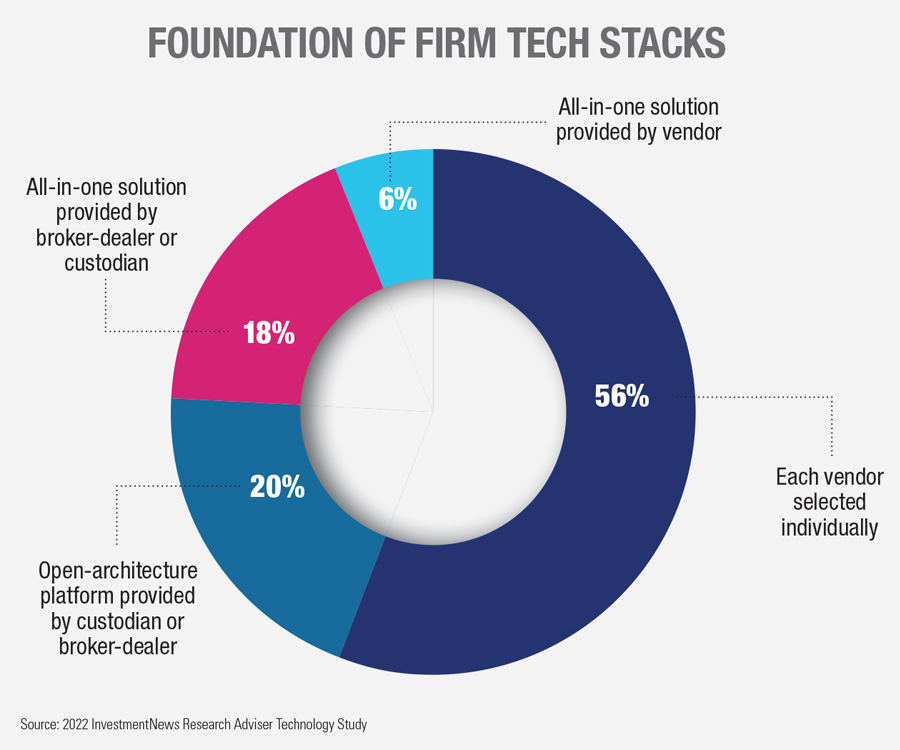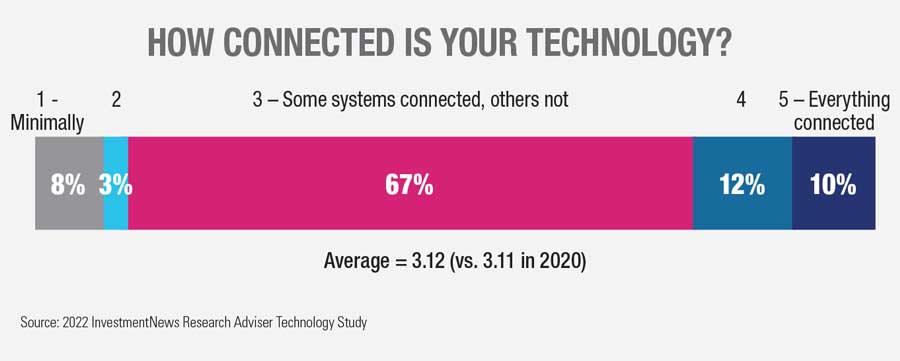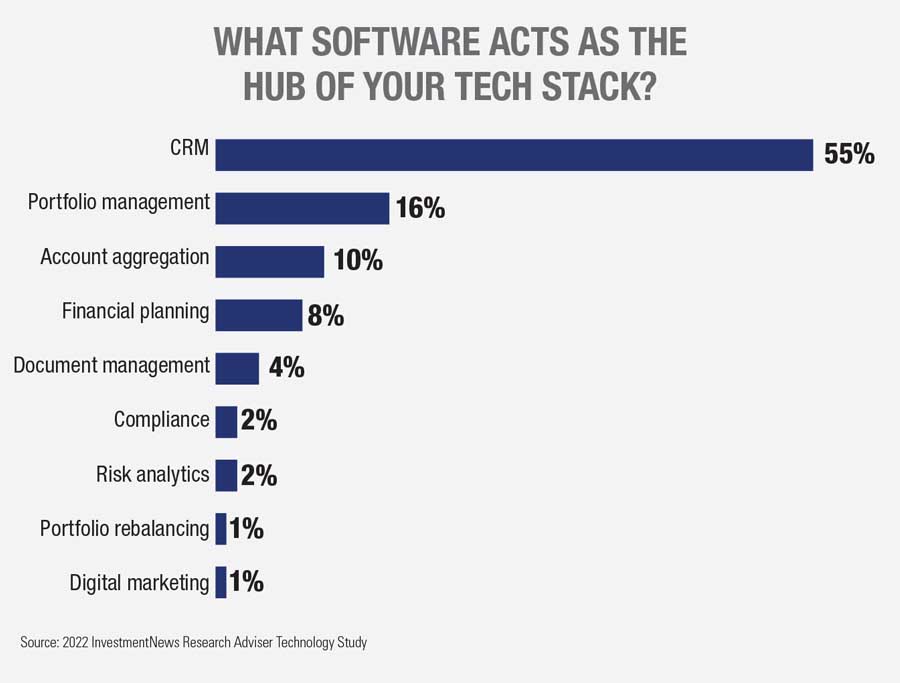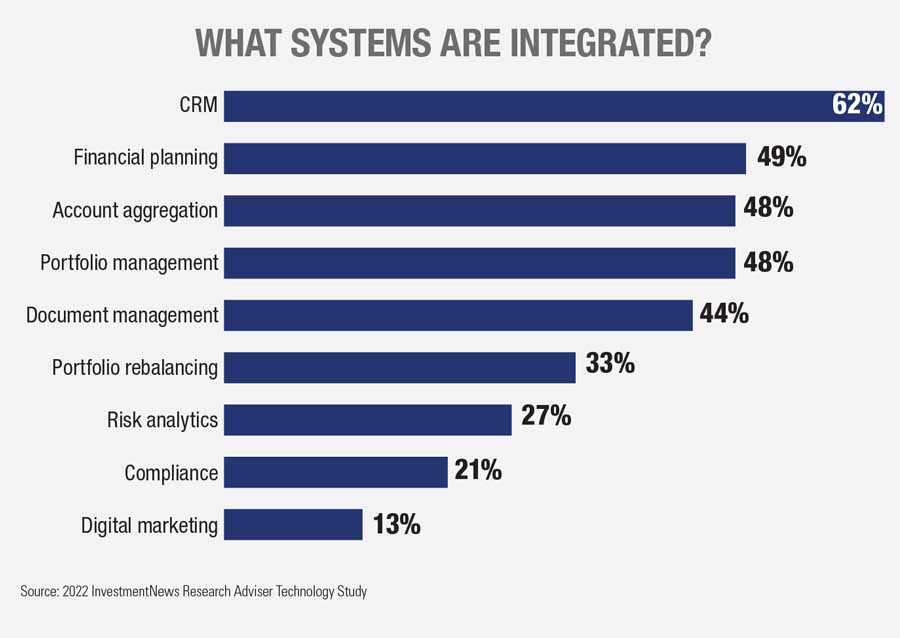

Michael Kelly, the founder of fee-only registered investment adviser Switchback Financial, starts each day logging into his client relationship management software, where he keeps his client notes, calendar and task list.
Kelly also spends a lot of time in his financial planning tool, which holds most of the cash flow data he needs to complete tasks on his agenda, but limited integration with the CRM means he is constantly switching and reentering data between the two programs.
“Say I’m reviewing property and casualty insurance for a given client, I need to know the cash flow data set. So, I get that in my financial planner, then switch back to the CRM, then go to my custodian, then back to the CRM, get my next task, then go back to the financial planning software to find that client and their information,” Kelly said. Sometimes the data is structured differently on different programs, leaving Kelly to figure out on his own how to format it. “If I could get all that data entry done in a single location, it could be a one-stop shop,” he said. “Some [fintechs] claim to have integration, but it’s so lackluster.”
"Some [fintechs] claim to have integration, but it’s so lackluster.”
Michael Kelly, founder, Switchback Financial
Kelly’s experience is familiar to many financial advisers. The typical firm uses five different technology vendors, and a third of firms are looking to add more, according to InvestmentNews Research’s 2022 Adviser Technology Study. However, 57% of advisers say the lack of integration between their core applications is the biggest pain point with technology.
“It’s kind of the craziest thing where some [fintechs] claim to have integration, but it’s so lackluster,” Kelly said. “Like, cool, you brought over the client’s name and birthday, but it’s the more detailed stuff that I really care about.”

Advisers expect the technology they use for work to keep up with what they see in consumer technology, said Kristen Schmidt, founder and president of technology consultancy firm RIA Oasis. Much of the integration touted by the industry boils down to simple connections like support for single sign-on, where logging into one fintech will log an adviser into other tools, or the ability to push data unilaterally from one software to another.
Today, advisers want to see changes made in one software automatically updated in every app across their tech stack, Schmidt said. “That is what everyone wants right now. We have a gap in this industry for data collection and updating between systems.”

More than just an inconvenience, the lack of integration can have a tangible impact on a firm. According to research firm Cerulli Associates, 94% of practice management professionals find limited technology integration creates productivity challenges.
“What it looks like today is wasted time,” said Ainslie Simmonds, the president of Pershing X, a new fintech-centric business unit within BNY Mellon.
The industry appears to be struggling to make progress. This is the second year in a row that respondents to the Technology Study cited integration as their top technology obstacle, and the third consecutive year it was cited as a top challenge by a majority of respondents. Two-thirds of advisers indicate that some of the systems are connected while others are not, and there has been little movement over several studies despite widespread recognition of it being a key obstacle.

The problem is structural within the industry, Simmonds said. Technology companies are encouraged by early investors to focus on solving a single issue like tax optimization, financial planning or portfolio construction, but there is no shared infrastructure for those companies to build on. New technology firms have gotten increasingly niche to break through in an ever-expanding crowded market.
“For example, we used to just have financial planning and now we have student loan planning, Social Security planning and estate planning software,” she said. “That’s going to continue to happen because all this fintech venture capital money that’s pouring in is saying ‘find your in, that’s the way to differentiate it.’ This problem is going to get worse before it gets better.”
Firms are left to either stitch things together themselves or rely on a partner, such as a custodian, to do it for them. InvestmentNews Research found 56% of advisers are selecting individual technology vendors to build their technology suite, while another 20% are using an open-architecture service provided by a custodian or broker-dealer.
At the same time, more established fintechs have expanded the services they provide, often through acquisition, to offer all-in-one solutions that promise greater connectivity. Adoption of these has been slower, with 18% of advisers saying they use a product provided by their custodian or B-D and just 6% saying they use an all-in-one solution provided by a vendor.

While these can be great for new firms starting with a digital blank slate, it’s more difficult for established firms to change multiple pieces of technology at once, said Robert Schultz, chief operating officer of Rollins Financial Advisors, an Atlanta-based RIA with $1.1 billion in assets under management.
“It is impossible to change everything simultaneously, so you have to slow roll the transition,” Schultz said. “An issue with slowing the shift is that what you thought might be an excellent solution today is not one-to-two years from now.”
Not every adviser is struggling with technology integration. While there is room for improvement, adviser fintech works better than it ever has before, said Chris Chen, the CEO of Insight Financial Strategies, a fee-only planning firm based in Boston.
“Most of the vendors that I use have a lot of direct integrations with all kinds of providers,” Chen said in an email. “What’s most difficult is not the integration of the technology, which often happens, it is the integration into workflows.”
Having documented, repeatable workflows is a best practice for firms to get the most out of their technology, said Schmidt. Firms should also have a dedicated person on staff to keep up with ongoing updates to technology integrations to update workflows accordingly and train the rest of the firm.
Firms are also finding success with selecting a single piece of technology to be the primary data hub that connects with the custodian, then using APIs to push that data to other fintechs. More than half of respondents said their CRM acts as their tech stack’s hub, and 62% said the CRM is the most fully integrated with other pieces of technology.
“I very much view it as the CRM should be the central hub,” Kelly said. “From there it should be able to take information to and from the financial planning software, tax planning software, performance management tool, custodian, etc. If they all played nice with the CRM, then it would serve as the ‘middleman,’ and you wouldn’t need integrations between every product.”
The goal is to create something like Microsoft’s Office 365 or Google’s G-Suite — a true fintech ecosystem for advisers, Simmonds said. But getting there will require a significant paradigm shift for many in the industry.
“We are not as good as big tech at really understanding the value of open architecture. We think we have to own everything,” Simmonds said. “I think that everybody who comes to this market thinking they’re going to own the adviser’s desktop is completely out of their mind.”

Relationships are key to our business but advisors are often slow to engage in specific activities designed to foster them.

Whichever path you go down, act now while you're still in control.

Pro-bitcoin professionals, however, say the cryptocurrency has ushered in change.

“LPL has evolved significantly over the last decade and still wants to scale up,” says one industry executive.

Survey findings from the Nationwide Retirement Institute offers pearls of planning wisdom from 60- to 65-year-olds, as well as insights into concerns.
Streamline your outreach with Aidentified's AI-driven solutions
This season’s market volatility: Positioning for rate relief, income growth and the AI rebound
